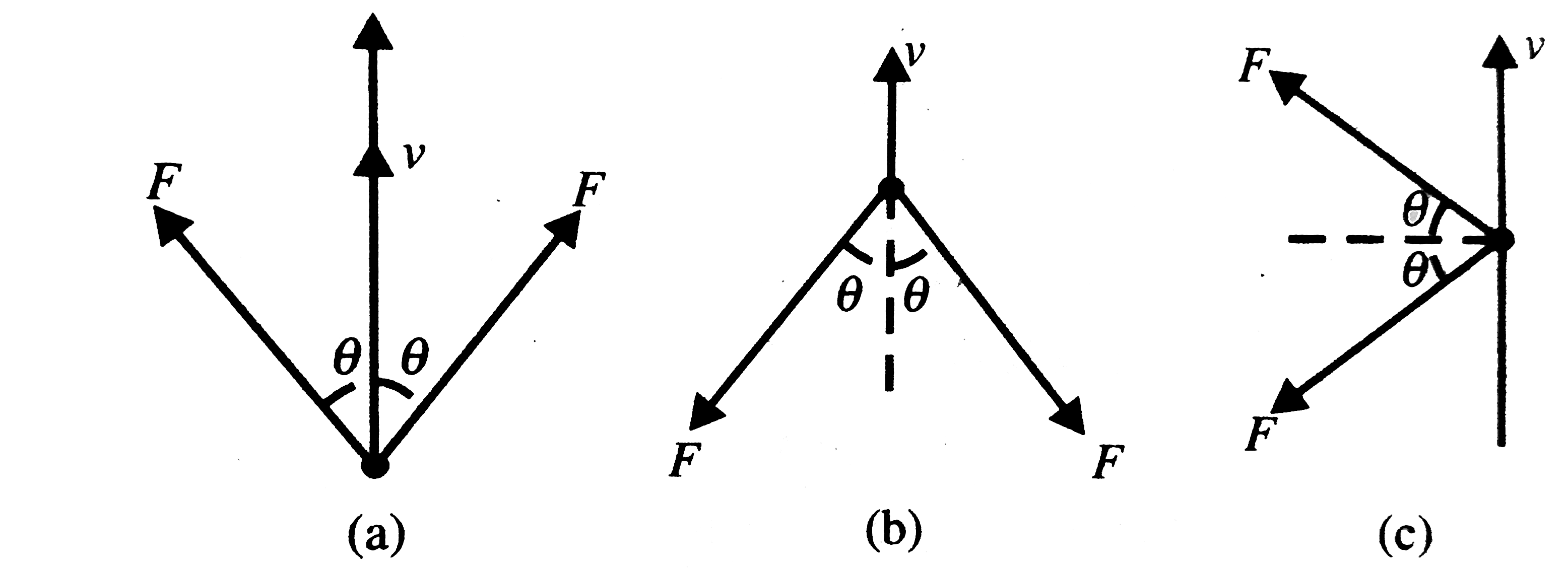The velocity →v of a particle of mass 'm' acted upon by a constant force is given by →v(t)=A[cos(kt)¯i−sin(kt)¯j] . Then the angle between the force and the momentum of the particle is (Here A and k are constants)
90∘
0∘
180∘
45∘
The correct Answer is:A
To solve the problem, we need to find the angle between the force acting on the particle and the momentum of the particle. Let's break this down step by step.
Step 1: Write down the expression for velocity
The velocity of the particle is given by:
→v(t)=A(cos(kt)^i−sin(kt)^j)
Step 2: Find the momentum of the particle
The momentum →p of the particle is given by:
→p(t)=m→v(t)=mA(cos(kt)^i−sin(kt)^j)
Step 3: Differentiate momentum to find force
The force →F acting on the particle is the time derivative of momentum:
→F=d→pdt
Calculating the derivative:
→F=ddt(mA(cos(kt)^i−sin(kt)^j))
Using the chain rule:
→F=mA(−ksin(kt)^i−kcos(kt)^j)
Thus, we can write:
→F=−mAk(sin(kt)^i+cos(kt)^j)
Step 4: Calculate the dot product of force and momentum
Next, we need to find the dot product →F⋅→p:
→F⋅→p=(−mAk(sin(kt)^i+cos(kt)^j))⋅(mA(cos(kt)^i−sin(kt)^j))
Calculating the dot product:
→F⋅→p=−m2A2k(sin(kt)cos(kt)−cos(kt)sin(kt))=0
Step 5: Find the magnitudes of force and momentum
The magnitudes of →F and →p are:
|→F|=mAk√sin2(kt)+cos2(kt)=mAk
|→p|=mA√cos2(kt)+sin2(kt)=mA
Step 6: Calculate the angle between force and momentum
The angle θ between the two vectors can be found using the formula:
cos(θ)=→F⋅→p|→F||→p|
Since →F⋅→p=0:
cos(θ)=0(mAk)(mA)=0
Thus, θ=cos−1(0)=90∘.
Final Answer
The angle between the force and the momentum of the particle is 90∘.
---
The velocity of the particle is given by:
→v(t)=A(cos(kt)^i−sin(kt)^j)
The momentum →p of the particle is given by:
→p(t)=m→v(t)=mA(cos(kt)^i−sin(kt)^j)
The force →F acting on the particle is the time derivative of momentum:
→F=d→pdt
Calculating the derivative:
→F=ddt(mA(cos(kt)^i−sin(kt)^j))
Using the chain rule:
→F=mA(−ksin(kt)^i−kcos(kt)^j)
Thus, we can write:
→F=−mAk(sin(kt)^i+cos(kt)^j)
Next, we need to find the dot product →F⋅→p:
→F⋅→p=(−mAk(sin(kt)^i+cos(kt)^j))⋅(mA(cos(kt)^i−sin(kt)^j))
Calculating the dot product:
→F⋅→p=−m2A2k(sin(kt)cos(kt)−cos(kt)sin(kt))=0
The magnitudes of →F and →p are:
|→F|=mAk√sin2(kt)+cos2(kt)=mAk
|→p|=mA√cos2(kt)+sin2(kt)=mA
The angle θ between the two vectors can be found using the formula:
cos(θ)=→F⋅→p|→F||→p|
Since →F⋅→p=0:
cos(θ)=0(mAk)(mA)=0
Thus, θ=cos−1(0)=90∘.
The angle between the force and the momentum of the particle is 90∘.
Topper's Solved these Questions
- LAWS OF MOTIONBOOK - AAKASH SERIESCHAPTER - LAWS OF MOTIONEXERCISE - PRACTICE EXERCISE
106 Videos
- LAWS OF MOTIONBOOK - AAKASH SERIESCHAPTER - LAWS OF MOTIONEXERCISE - EXERCISE - I
157 Videos
- GEOMETRICAL OPTICSBOOK - AAKASH SERIESCHAPTER - GEOMETRICAL OPTICSEXERCISE - ADDITIONAL PRACTICE EXERCISE (LEVEL-II PRACTICE SHEET (ADVANCED) INTEGER TYPE QUESTIONS)
10 Videos
- LOGIC GATESBOOK - AAKASH SERIESCHAPTER - LOGIC GATESEXERCISE - Exercise (Very Short Answer)
10 Videos
Similar Questions
A particle moves in the xy plane under the influence of a force such that its linear momentum is →P(t)=A[ˆicos(kt)−ˆjsin(kt)], where A and k are constants. The angle between the force and momentum is
View SolutionA particle of mass m is acted on by two forces of equal magnitude F maintaining their orientation relative to the velocity v as shown in Fig. The momentum of the particle

View Solution
Knowledge Check
Angular momentum of the particle rotating with a central force is constant due to
Aconstant torqueBconstant forceCconstant linear momentumDzero torque
A particle of mass m is acted upon by a force F=t2−kx . Initially , the particle is at rest at the origin. Then
View SolutionIf a constant force acts on a particle, its acceleration will
View SolutionA particle moves 5m in the +x direction while being acted upon by a constant force→F=(4N)ˆi+(2N)ˆj−(4N)ˆk . The work done on the particle by this force is
View SolutionThe velocity of the particle of mass m as a function of time t is given by v=Aω.cos[√Kmt] , where A is amplitude of oscillation. The dimension of AK is
View SolutionA particle of mass m is acted upon by a force F given by the emprical law F=Rt2υ(t)
If this law is to be tested experimentally by observing the motion starting from rest, the best way is to plot :
View SolutionThe magnitude of torque on a particle of mass 1 kg is 2.5 Nm about the origin.If the force acting it is 1 N, and the distance of the particle from the origin is 5 m, the angle between the force and the position vector is (in radians):
View SolutionStatement 1: A charged particle undergoes non-rectilinear motion in a constant magnetic field. The only force acting on the particle is the magnetic force. Then kinetic energy of this particle remains constant but momentum of the particle does not remains constant.
Statement 2: A force that always acts on the particle in direction perpendicular to its velocity does no work on the particle. But whenever a force acts on the particle, momentum of the particle does not remains constant.
View Solution
